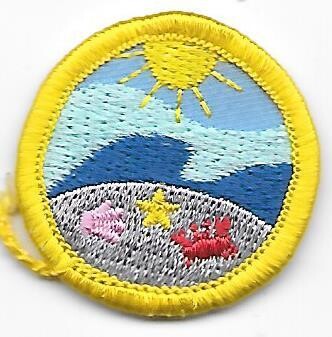Beaches Forever Jersey Shore Council own Junior Badge (Original)
Requirements:
Complete seven activities
1. Before you visit the beach, learn the importance of sand dunes; how to read a tide chart and learn the effects of storms on the beach. Discuss or write with your troop how people can help preserve the natural formation of the beach and dunes? Take a beach walk. Remember when you leave to take nothing with you but photographs.
2. Find evidence of living plants and animals on the beach and along the shore. Identify shells, egg cases, crabs, grasses, and seaweeds.
3. Learn how plastics are a great danger to sea life and how pollution harms the balance of beach life. Discuss with your troop how people can help prevent the damage caused by our society.
4. Visit a nature center near or at the beach. Interview a person who works there. Find out how she/he got her/his job and what education she/he needs to perform the job. What are the job responsibilities?
5. What is a barrier reef (a sand bar)? Why is it a fragile eco-system? Visit both the bay and an ocean front, compare how the eco-systems are alike and how they are different. Find examples of eel grass, scrub pine, and other bay side foliage. What animal life thrives on the bay side? Remember our natural parks have rangers who can assist.
6. Learn about the horseshoe crab, which really isn’t a crab at all. What is it and how long has it been here on earth? Research the laws protecting this animal or write a new law that would help.
7. Visit a seashore historic site such as a lighthouse or a Coast Guard Station. Learn the history of the area’s lifestyle and how it has changed through the years.
8. Interview someone who has lived near the seashore all his/her life. Do you share the same interests such as shell collecting, fishing, surfing or crabbing? Where are some other beaches you would like to visit?
9. Participate in a beach litter pick-up, make signs to Keep of the Dunes, organize a beach ecology display or give a presentation on beach ecology for younger Girl Scouts.
10. What legends, beach stories, or poems can you find to spark your imagination and love for the seashore life? Examples are: pirates, mermaids, fisherman tales, lighthouse workers, sailors, surfers. Build a sandcastle and then watch the effects of the tide.
11. Create a seashore scene in a piece of artwork such as a painting, fish printing, shell mobile or a collage. Use this as part of your beach ecology presentation or to decorate your room.
12. Learn the dangers of the shore weather, such as storms, riptides, undertow, hurricane warnings, and the necessity of storm evacuation routes. Review beach safety rules with younger Girl Scouts such as “never swim alone”, “only swim at guarded beaches”, and “look before you leap”. Use Safety-Wise as a guide.
